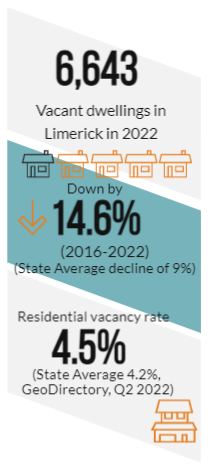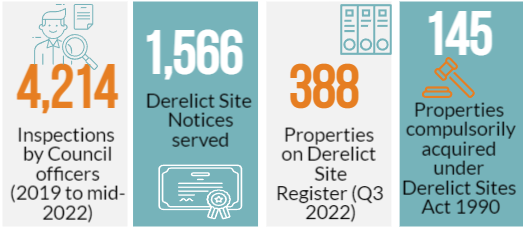2.11 Dereliction and Vacancy
Dereliction and vacancy of buildings and sites in cities, towns and villages and abandoned rural dwellings are the hallmarks of decline.
Residential Vacancy
In Limerick City and County, the total number of vacant dwellings in 2022 was 6,643 giving a vacancy rate of 7.7%, slightly lower than the national average (7.8%). The re sidential vacancy rate in Limerick in 2022 declined by 14.6% compared with 2016 and, as such, reduced at a faster rate compared with the state average (-9%). Based on Census 2022 data, the dominant pattern across the state shows large numbers of vacant dwellings in more rural areas. This pattern is reflected in Limerick where some towns and villages in rural Limerick show high rates of residential vacancy.
sidential vacancy rate in Limerick in 2022 declined by 14.6% compared with 2016 and, as such, reduced at a faster rate compared with the state average (-9%). Based on Census 2022 data, the dominant pattern across the state shows large numbers of vacant dwellings in more rural areas. This pattern is reflected in Limerick where some towns and villages in rural Limerick show high rates of residential vacancy.
Using a different source of data, for Q2 2022, the GeoDirectory reported a residential vacancy rate for Limerick of 4.5%, slightly higher than the national average (4.2%) based on this source of data.
High residential vacancy levels can reflect preference for households to locate in suburban and peri-urban areas, nearer to work and services, and to outskirts of towns / settlements and open countryside. Movement out of town and village centres is also linked to changed expectations in relation to standards and quality of housing. These shifts in populations were identified from the analysis a cross-section of settlements in rural Limerick and are in evidence for some time, particularly from 2001.
Commercial Vacancy
Based on GeoDirectory Commercial Buildings Report, the national commercial vacancy rate in Q2 2022 was 13.9% (showing an increased by 0.25 percentage points compared with the situation in Q2 2021). The commercial vacancy rate recorded in 2022 is the highest it has been since 2013.[1] Across the state, commercial vacancy rates are generally higher in the west and north west (Donegal and western counties).
County Limerick (the whole local authority area) is amongst the counties with a relatively high commercial vacancy rate at 16.6% (above the average for Munster 13.8% and seventh highest in the state). Compared with the previous 12 months, the commercial vacancy rate in Limerick increased by 0.4 percentage points.
Factors associated with the current situation include challenges faced by businesses and the economy post COVID, increased energy and other input costs, increased inflation (linked to the war in Ukraine), tight labour market conditions and wage inflation.

Based on NACE (Nomenclature of Economic Activities) codes, in the state as a whole, businesses in the services sector account for 49% of commercial vacancy. Businesses in the accommodation and food sector account for 29% of commercial vacancy followed by retail and wholesale (22%). In Limerick City and County, 47% of commercial vacancies are in the services sector.
In terms of locations with highest vacancy rates, one Limerick town, Abbeyfeale, was amongst the 15 towns in the state with the highest commercial vacancy rates, at 22.1% in Q2 2022, an increase of 1.6 percentage points compared with Q2 2021. In addition to Abbeyfeale, Newcastle West (21.6%) and Limerick City (19.1%) were amongst the towns / areas with the highest commercial vacancy rates in Munster.
Addressing vacancy and dereliction in the city, in the core of towns and villages and bringing these buildings back into productive use – for commercial, residential, civic and community uses - is a priority policy issue. Conversion of use - e.g., from commercial to residential and community uses – can be appropriate for older buildings in towns and villages (former shops, vacant units over shops and other commercial premises). Physical renewal can support the creation of compact, attractive, vibrant and safe environments.
Council Action on Vacancy & Dereliction
The issue of vacancy is being addressed with a comprehensive response by Limerick City and County Council in the city and rural Limerick. The Council set up a Dereliction Vacancy and Re-use Unit in 2018, staffed by a multi-disciplinary team, including a full-time Vacant Homes Officer. The team works with an area-based approach identifying vacant properties and sites and taking action including legal powers of the Council and engagement with property owners to bring them back to productive uses. From 2019 to mid-2022, 4,214 inspections were completed by Council officers and 1,566 Derelict Site Notices served under the Derelict Sites Act 1990. Engagement with property owners typically leads to a significant number of derelict / vacant units being enhanced or brought back to use. In Q3 2022, 388 properties are on the Derelict Sites register and 145 properties have been compulsorily acquired under the Derelict Sites Act 1990. The majority of derelict sites / buildings are made available for sale on the open market (76 sold since 2019) and some are retained by the Council for use as social housing, re-development as private housing for sale under a Rural Housing Initiative or for community / tourism uses. The recently-introduced Croí Conaithe (Towns) Vacant Property Refurbishment Grant has increased interest in vacant properties for sale, for re-use as housing.
